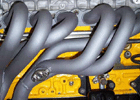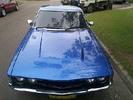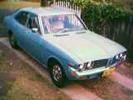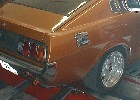| Author | Topic |
|---|

I supported Toymods
Location:
I renounced punctuation
Registered:
May 2002
|
|
Titanium conrods and cycle fatigue
|
 Sat, 04 September 2004 01:35
Sat, 04 September 2004 01:35

|
 |
What I have read suggests that it is very good, but then I have heard stories that it isn't (although it is better than aluminium).
Apparently the usual alloy for Ti conrods is Ti 6-4 (6Al, 4V - I presume this refers to the amount of aluminium and vanadium in the alloy).
Do those in the know wish to comment?
|
|
|

I supported Toymods
Location:
melbourne
Registered:
June 2002
|
|
Re: Titanium conrods and cycle fatigue
|
 Mon, 06 September 2004 01:05
Mon, 06 September 2004 01:05
 
|
 |
comment on what?
i cant really comment on the alloy composition, but i know that the later honda NSXs use titanium con-rods.
i remember something about titanium not being so good in areas of cyclic fatigue (akin to aluminium)in one of my engineering electives, it is definately not as good as steel.
are you getting the rods custom made? are just normal forged rods unsuitable for some reason?
|
|
|

Location:
Lost in the K hole
Registered:
May 2002
|
|
Re: Titanium conrods and cycle fatigue
|
 Mon, 06 September 2004 01:07
Mon, 06 September 2004 01:07
 
|
 |
steel = heavy = rotational intertia - hence the desire to go Ti
wheres stewy 
|
|
|

Location:
Lost in the K hole
Registered:
May 2002
|
|
Re: Titanium conrods and cycle fatigue
|
 Mon, 06 September 2004 01:13
Mon, 06 September 2004 01:13
 
|
 |
btw dave - we used to build xc race bikes out of 6AL 4V, lights as shit, with a very nice natural damping quality to the frames - far superior to chromoly steel.
and whilst we never had a fatigue related failure in any component or weld, ALL major manufactueres steered WELL away from building any of the downhill bikes out of Ti - FAR too punishing use. for those odd custom DH Ti bikes that did pop up - they all broke.
totally anecdotal, and far too many factors at play to say why these bike broke (as did many many 7075 T6 frames, Easton frames, and carbon fibre/thermoplastic frames (ugghhh!!)).
best frames ever were reynolds cromo, or 4130 cromo
food for thought
|
|
|

Location:
Adelaide
Registered:
January 2004
|
|
Re: Titanium conrods and cycle fatigue
|
 Mon, 06 September 2004 02:03
Mon, 06 September 2004 02:03
 
|
 |
I suppose the first thing so say, is that all fatigue is caused by cycles, as this creates fluctuating stresses in the part that cause small cracks or manufactring defects to move through the part, causing fatigue faliures.
As far as the fatigue limit (number of cycles) of titanium conrods compared with aluminium or steel, it depends on the tensile strenght or tensile stress (stress that has to be applied before the material will break) of the matrerials. Generally the higher the tensile strenght, the higher the fatigue limit is.
I would suspect that titanium conrods would be much better then aluminium as I suspect the particular alloy would have a higher tensile strenght. However, I am not familar with this particular alloy and couldn't be sure without doing some research that I really don't have time for (sorry!)
Steel (depending on the grade) is still probably better...
The surface finish of the part, manufacturing and the design have alot to do with fatigue. Poor machining, deep scratches, sharp corners and manufacturing defects can all lead to fatigue cracks and ultimately failure.
Hope that helps!
|
|
|

I supported Toymods
Location:
I renounced punctuation
Registered:
May 2002
|
|
Re: Titanium conrods and cycle fatigue
|
 Mon, 06 September 2004 02:20
Mon, 06 September 2004 02:20
 
|
 |
All my reading in the last week would suggest that Ti is way better than aluminium and from what I can gather possibly better than steel.
Where it wins out majorly is strength for weight compared to steel. Expense seems to be the limiting factor.
I suppose the question I really want answered is, "Will a Ti rod be able to tolerate 5000+ ft/min average piston speed?" I suspect that is dependent upon more things than just rod composition so there is probably no simple yes or no answer.
|
|
|

I supported Toymods
Location:
I renounced punctuation
Registered:
May 2002
|
|
Re: Titanium conrods and cycle fatigue
|
 Mon, 06 September 2004 02:32
Mon, 06 September 2004 02:32
 
|
 |
| Lachie wrote on Mon, 06 September 2004 12:03 |
As far as the fatigue limit (number of cycles) of titanium conrods compared with aluminium or steel, it depends on the tensile strenght or tensile stress (stress that has to be applied before the material will break) of the matrerials. Generally the higher the tensile strenght, the higher the fatigue limit is.
I would suspect that titanium conrods would be much better then aluminium as I suspect the particular alloy would have a higher tensile strenght. However, I am not familar with this particular alloy and couldn't be sure without doing some research that I really don't have time for (sorry!)
Steel (depending on the grade) is still probably better...
|
Just searching thru the matweb database of materials and it would appear that Ti-6-4 has a similar tensile strength compared to 4340 steel (what most billet conrods are made of).
Thanks again....all food for thought.
|
|
|

I supported Toymods
Location:
Perth
Registered:
May 2002
|
|
Re: Titanium conrods and cycle fatigue
|
 Mon, 06 September 2004 02:36
Mon, 06 September 2004 02:36
 
|
 |
|
Don't the current crop of Porsche GT3 and Ferrari 360 GT Race/Road cars use titanium conrods? Surely if they can meet a company like Porsche's reliability standards yet perform so reliably on a track they should be up to the task?
|
|
|

Location:
Sydney
Registered:
May 2002
|
|
Re: Titanium conrods and cycle fatigue
|
 Mon, 06 September 2004 03:03
Mon, 06 September 2004 03:03
 
|
 |
and titanium is nice and cheap 
|
|
|

I supported Toymods
Location:
I renounced punctuation
Registered:
May 2002
|
|
|

I supported Toymods
Location:
Perth
Registered:
May 2002
|
|
Re: Titanium conrods and cycle fatigue
|
 Mon, 06 September 2004 03:28
Mon, 06 September 2004 03:28
 
|
 |
|
True that, but its food for thought. Surely around the net there has to be some information about their composition.
|
|
|

Location:
Lost in the K hole
Registered:
May 2002
|
|
Re: Titanium conrods and cycle fatigue
|
 Mon, 06 September 2004 03:32
Mon, 06 September 2004 03:32
 
|
 |
i have a suspicion that youll find, as with everything, its going to be a compromise. you want 10,000 rpm and 5000ft/min peak velocities (and god knows what acceleration forces at TDC BDC) then stuff isnt going to last...
i hate compromises 
|
|
|

I supported Toymods
Location:
I renounced punctuation
Registered:
May 2002
|
|
Re: Titanium conrods and cycle fatigue
|
 Mon, 06 September 2004 04:17
Mon, 06 September 2004 04:17
 
|
 |
| ed_ma61 wrote on Mon, 06 September 2004 13:32 |
i hate compromises
|
Say "NO" to compromises!
Stupid long stroke 2JZ.....
1JZ gets to have all the fun ....stupid 4000 ft/min at 9500rpm...
|
|
|

Location:
Kita-Ku, Sapporo, Japan
Registered:
January 2003
|
|
Re: Titanium conrods and cycle fatigue
|
 Mon, 06 September 2004 04:57
Mon, 06 September 2004 04:57
 
|
 |
| ed_ma61 wrote on Mon, 06 September 2004 11:07 |
wheres stewy 
|
in NZ skiing  heh heh... heh heh...
i don't know if i can help the public knowledge effort much.. Ti is used for 'low to medium temp' jet turbine blades becuase of a few things... strength to weight ratio and creep resistance.. but mostly because of weight. large blade = heavy. stronger material = less material used. less dense material = even less material used.
there are so many factors involved here (piston weight, rpm, heat and processing treatments, geometry, etc etc) that it's hard to give a better answer than "it depends" 
decreasing piston weight reduces load at TDC at start of intake stroke, and that will increase the life of any rod.
as Ed said... at that rpm, stuff isn't going to last long... hopefully it will last "long enough" 
Cya, Stewart
|
|
|
Location:
Christchurch, New Zealand
Registered:
March 2004
|
|
|
Location:
Vancouver
Registered:
June 2004
|
|
Re: Titanium conrods and cycle fatigue
|
 Mon, 06 September 2004 06:04
Mon, 06 September 2004 06:04
 
|
 |
If you are planning to run a high horsepower turbo/supercharged motor, don't bother with Ti rods; get some 4340 rods and spend the money on something else that will actually make more power...
On the other hand, if you are trying to win some specific class, and the rules allow Ti rods, and your budget allows for their cost, and there is some financial gain to be had in beating the competition, then the use of Titanium rods would be justified...
Titanium itself doesn't really make any "magical" extra power; it lets you drop the mass of the reciprocating assembly, allowing you to "potentially" raise the safe operating RPM of the lower end, but when you have gotten to that point, stresses go through the roof with increases in rpm, as opposed to the moderate increase of stresses induced by more radical levels of charge stratification.
So, if you are going to run Titanium rods, the geometry of the motor better be pretty shit-hot, and the valvetrain better be good for more than 10,000rpm, and all of the other exorbatent costs associated with super-RPM motors... and it's lifespan will be measurable in hours rather than the years available from a moderatly high output turbo/supercharged motor...
As one noted engine builder said, "RPM is an acronym for ruins people's motors!" High RPM is exactly what Ti rods will let you run...
|
|
|

Location:
Rosanna, Melb
Registered:
June 2002
|
|
Re: Titanium conrods and cycle fatigue
|
 Mon, 06 September 2004 06:38
Mon, 06 September 2004 06:38
 
|
 |
An anecdote told by one of my mechanics lecturers centred around a racer neighbour of his who had problems with some titanium rods because of their extra "stretch".
Given the lower Young's modulus of Ti they will elongate/compress more, especially given the forces produced at high RPM.
I've never done the maths, so cant vouch for the accuracy, but bear this in mind.
Hen
|
|
|

Location:
Melbourne
Registered:
May 2002
|
|
Re: Titanium conrods and cycle fatigue
|
 Mon, 06 September 2004 08:48
Mon, 06 September 2004 08:48
 
|
 |
| justcallmefrank wrote on Mon, 06 September 2004 13:28 |
True that, but its food for thought. Surely around the net there has to be some information about their composition.
|
I highly doubt that companies like Porsche would give out the composition of the alloy's used in their conrods, though there may be a disgruntled employee. LOL
Cheers Adam
|
|
|

I supported Toymods
Location:
I renounced punctuation
Registered:
May 2002
|
|
Re: Titanium conrods and cycle fatigue
|
 Mon, 06 September 2004 09:20
Mon, 06 September 2004 09:20
 
|
 |
| Fattony wrote on Mon, 06 September 2004 18:48 |
I highly doubt that companies like Porsche would give out the composition of the alloy's used in their conrods, though there may be a disgruntled employee. LOL
|
Interestingly, it's out there.
Year Component Material Manufacturer Model
1992 Connecting rods Ti-3Al-2V-rare earth Honda Acura NSX
1994 Connecting rods Ti-6Al-4V Ferrari All 12-cyl
1996 Wheel rim screws Ti-6Al-4V Porsche Sport wheel option
1998 Brake pad guide pins Ti grade 2 Daimler S-Class
1998 Brake sealing washers Ti grade 1s Volkswagen All
1998 Gearshift knob Ti grade 1 Honda S2000 Roadster
1999 Connecting rods Ti-6Al-4V Porsche GT3
1999 Valves Ti-6Al-4V & PM-Ti Toyota Altezza 4-cyl.
1999 Turbo charger wheel Ti-6Al-4V Daimler Truck diesel
2000 Suspension springs TIMETAL LCB Volkswagen Lupo FSI
2000 Wheel rim screws Ti-6Al-4V BMW M-Techn. option
2000 Valve spring retainers beta-titanium alloys Mitsubishi All 1.8 l – 4-cyl.
2000 Turbo charger wheel gamma-TiAl Mitsubishi Lancer
2001 Exhaust system Ti grade 2 General Motors Corvette Z06
2001 Wheel rim screws Ti-6Al-4V Volkswagen Sport package GTI
2002 Valves Ti-6Al-4V & PM-Ti Nissan Infiniti Q45
2003 Suspension springs TIMETAL LCB Ferrari 360 Stradale
You'll notice the S2000's gearshift knob is made out of titanium - that has to be factory sanctioned rice. 
Thankyou for the references Stewart.
|
|
|

I supported Toymods
Location:
Perth
Registered:
May 2002
|
|
Re: Titanium conrods and cycle fatigue
|
 Mon, 06 September 2004 10:23
Mon, 06 September 2004 10:23
 
|
 |
|
Wooh yeah!
|
|
|
Location:
Christchurch, New Zealand
Registered:
March 2004
|
|
Re: Titanium conrods and cycle fatigue
|
 Mon, 06 September 2004 23:53
Mon, 06 September 2004 23:53
 
|
 |
Yeild Strength
Ultimate Strength
True Facture Strenth
Toughness (Mpa root(m)
100%elongatoin
to failure
reduction in area
AISI 4340 1103 1172 1634 110 14 49
ti-6AL-4V 1185 1233 1717 66 16 34
Mechanical Behavhiour of MAterial, Norman E Dowling. table 9.1
Logan
|
|
|

I supported Toymods
Location:
Sydney
Registered:
September 2003
|
|
Re: Titanium conrods and cycle fatigue
|
 Tue, 07 September 2004 04:35
Tue, 07 September 2004 04:35
 
|
 |
http://www.imeche.org.uk/tribology/pdf/Luo.pdf
That kind of touches on the subject, its actually about surface fatigue for automotive gears. if you could access the references especially number 5 (without paying), they could help be more helpful.
Seems like that particular alloy (and ti alloys generally) have a good fatigue/endurance limit (580 Mpa @ 10^7 cycles), this seems comparable to 4340 - although i can never find the same number twice for that sort of data! The fact that it has an endurance limit is good, means (theoretically) you can keep stressing it to <580mpa forever (  ), whereas aluminium alloys the value keeps dropping to zip. ), whereas aluminium alloys the value keeps dropping to zip.
But it seems they do wear pretty poorly under friction, unless treated- which is what that article's about.
That doesn't really answer your piston speed q, but you get that..
its amazing how much fun you can have with other people's problems when you dont want to work on your own 
|
|
|

Location:
Kita-Ku, Sapporo, Japan
Registered:
January 2003
|
|
Re: Titanium conrods and cycle fatigue
|
 Tue, 07 September 2004 05:44
Tue, 07 September 2004 05:44
 
|
 |
the reason you never see the same numbers twice for fatigue related properties is because "it depends".
depends on size of specimen, size of starter notch, load applied, rate of loading, even the time of each loading cycle. to compare data, you would need the EXACT same experimental conditions, and even then, it's difficult to ensure that the starter crack properties are EXACTLY alike...
full title for that article (5) is
TI: Surface engineering of titanium alloys for the motorsports industry
AU: Dong, H; Bell, T; Mynott, A
SO: Sports Engineering. Vol. 2, no. 4, pp. 213-219. 1999
| Quote: |
AB: Abstract
The ever increasing demands of motorsports has been the main driving force for substituting titanium components for steel in racing cars and engines by virtue of their higher strength to weight ratio. This allows savings in general weight and inertial energy, and allows a more beneficial weight redistribution in the car. However, the poor tribological properties of titanium alloys has restricted such replacement, and the full potential of titanium alloys in racing cars will not be realised until some novel surface engineering technologies have been developed. An innovative surface engineering technique developed by Dong et al. can successfully improve the tribological behaviour of titanium alloys in terms of low friction, high wear resistance and high resistance to scuffing. This has made possible the regular use of titanium components in Formula 1 and Indy cars engines. Furthermore, with the aid of a recently developed predictive contact mechanics model, some novel duplex systems have been designed to meet the challenging demands for the design of high dynamically loaded titanium gears. The duplex treated titanium gears have satisfactorily completed rigorous cam rig tests under a pick-up load of 50 Nm at speeds up to 17000 r.p.m., which could pave the way for the use of titanium alloys in gear boxes. The present paper demonstrates, by way of example, a number of major steps towards titanium designer surfaces. The motorsports industry has recognised the potential of surface engineered titanium components and it is envisaged that the new Millennium will see wide applications of titanium in the motorsports industry. Materials include Ti-6Al-4V.
|
i should have access, but apparently not from home.
funnily enough i DO have online access to "sports illustrated" tho 
UTS and sydney uni students have access.
Cya, Stewart
|
|
|

I supported Toymods
Location:
Sydney
Registered:
September 2003
|
|
Re: Titanium conrods and cycle fatigue
|
 Tue, 07 September 2004 06:00
Tue, 07 September 2004 06:00
 
|
 |
hmmm.. not this sydney uni student 
when i go into that database logged in as sydney uni it still asksme to cough up $37.75! tells me im not a subscriber.
because i use the uni isp at home, i can go wherever i could go on campus, so it seems we dont subscribe to that. we do subscribe to other journals in the 'ingenta' db though, which is where i found it.
i too have access to sports illustrated though! 
|
|
|

Location:
Lost in the K hole
Registered:
May 2002
|
|
Re: Titanium conrods and cycle fatigue
|
 Tue, 07 September 2004 06:58
Tue, 07 September 2004 06:58
 
|
 |
| oldcorollas wrote on Tue, 07 September 2004 15:44 |
the reason you never see the same numbers twice for fatigue related properties is because "it depends".
depends on size of specimen, size of starter notch, load applied, rate of loading, even the time of each loading cycle. to compare data, you would need the EXACT same experimental conditions, and even then, it's difficult to ensure that the starter crack properties are EXACTLY alike...
full title for that article (5) is
TI: Surface engineering of titanium alloys for the motorsports industry
AU: Dong, H; Bell, T; Mynott, A
SO: Sports Engineering. Vol. 2, no. 4, pp. 213-219. 1999
|
stewy - what database can i find "Sports Engineering" journal under? i can dig it up from here and post it if you can give me some clues
cheers
ed
[Updated on: Tue, 07 September 2004 06:58]
|
|
|

Location:
Lost in the K hole
Registered:
May 2002
|
|
|

Location:
Madrid - Spain
Registered:
August 2002
|
|
Re: Titanium conrods and cycle fatigue
|
 Tue, 14 September 2004 12:35
Tue, 14 September 2004 12:35

|
 |
| gianttomato wrote on Sat, 04 September 2004 11:35 |
Apparently the usual alloy for Ti conrods is Ti 6-4 (6Al, 4V - I presume this refers to the amount of aluminium and vanadium in the alloy).
|
Yup the Al and V are the aluminium and vandium content in the alloy. 6Al-4V is commonly referred to as commercial grade titanium.
The keys to improved fatigue life are
1. Minimize peak and normal stresses ie reduce revs or reduce piston weight.
2. Remove any crack starters - polish the rod
3. Try and toughen the rod surface to resist cracking. I am not sure about Ti but Ally can be cold worked to improve fatigue cracking.
The advantage in ti rods is more that due to the better strength to weight ratio, you can increase the cross sectional area of the rod and reduce the stress (increase strength) and still reduce the weight. Obviously the ratio of these depends on how long you expect the engine to last.
As someone mentioned earlier, reducing piston weight will have a big effect on what your safe RPM will be. However once again this is a balancing act as it may then struggle with heat dissipation.
|
|
|